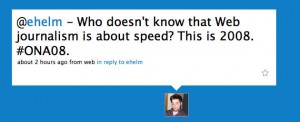Pat Thornton reports that funding for the site he edits, BeatBlogging – part of the NewAssignment.net project will cease on September 1.
“The fate of BeatBlogging.Org is undecided for now. I can at least assure you that the site will not be going away, as it is too strong of a new media brand to let die or even languish,” he writes.
“Being the editor of BeatBlogging.Org has been a great ride. I’ve learned a lot about how beat reporters are adapting to the web, how social media is changing journalism and where journalism is heading.
“Working with NYU’s Jay Rosen has been a great learning experience. It’s very invigorating to work with someone who is interested in answering, “what’s next?” And in journalism, that’s the No. 1 question we all must answer.
“What’s next for me? I don’t know yet. I hope to be able to contribute to the search for journalism next.”

